VII Corps (United States)
The VII Army Corps of the United States Army was one of the two principal corps of the United States Army Europe during the Cold War. Activated in 1918 for World War I, it was reactivated for World War II and again during the Cold War. During both World War II and the Cold War it was subordinate to the Seventh Army, or USAREUR and was headquartered at Kelley Barracks in Stuttgart, West Germany, from 1951 until it was redeployed to the US after significant success in the Gulf War in 1991, then inactivated in 1992.
| VII Army Corps | |
|---|---|
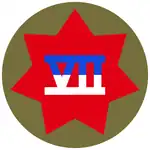 Shoulder sleeve insignia of VII Corps | |
| Active | 1918–19 1921-27 1941–46 1950–92[1] |
| Country | |
| Branch | |
| Nickname(s) | The Jayhawk Corps |
| Engagements | World War I |
| Commanders | |
| Notable commanders | Robert C. Richardson Jr. J. Lawton Collins Julius W. Becton Jr. John Galvin Frederick M. Franks, Jr. James M. Gavin |
| Insignia | |
| Distinctive unit insignia |  |
| Shoulder sleeve insignia prior to 28 April 1944 |  |
| U.S. Corps (1939–present) | ||||
|
World War I
VII Corps was organized at the end of World War I on 19 August 1918, at Remiremont, France and was inactivated on 11 July 1919.[1] It was commanded by Major Generals William M. Wright, Omar Bundy, William G. Haan, and Henry Tureman Allen.[2] It was composed of the 6th, 81st and 88th Divisions, and served in the Vosges Sector.[2]
Post-World War I
The VII Corps was reactivated as part of the Organized Reserve (OR) on 29 July 1921 and inactivated on 18 October 1927.[1] It was allotted to the Seventh Corps Area and assigned to the Third Army. In accordance with General Order #2, HQ, Seventh Corps Area, the Corps Headquarters was activated on 9 January 1922 at the Old Customhouse, 3d and Olive Streets, St. Louis, MO, with Regular Army and OR personnel.[3]
World War II
VII Corps was reactivated at Fort McClellan, Alabama 25 November 1940 and participated in the Louisiana Maneuvers staged as the US Army prepared for World War II. In late December 1941, VII Corps HQ was moved to San Jose, California as part of the Western Defense Command and as it continued to train and prepare for deployment.[4]
Its first return to continental Europe took place on D-Day in June 1944, as one of the two assault corps for the U.S. First Army during Operation Overlord, targeting Utah Beach via amphibious assault. For Overlord, the 82nd and 101st Airborne Divisions were attached to VII Corps.[5] After the Battle of Normandy the airborne units were assigned to the newly created XVIII Airborne Corps. Subsequently, VII Corps participated in many battles during the advance across France; this included taking 25,000 German prisoners during the Battle of the Mons Pocket in early September 1944.[6] The corps subsequently took part in the invasion of Germany until the surrender of the Third Reich in May 1945. The corps was inactivated in 1946.
Battle of Normandy
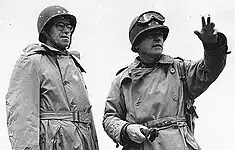
For the Normandy Operation, VII Corps was part of 21st Army Group under the command of General Bernard Montgomery and the U.S. First Army commanded by Lieutenant General Courtney Hodges. The Corps was commanded by Major General J. Lawton Collins.
VII Corps led the initial assault of Operation Cobra, the First Army-led offensive as part of the breakout of the Normandy area. Its success is credited with changing the war in France from high-intensity infantry combat to rapid maneuver warfare.
Assigned Units and Commanders
 4th Infantry Division, Major General Raymond O. Barton
4th Infantry Division, Major General Raymond O. Barton
- 8th Infantry Regiment Colonel James A. Van Fleet
- 12th Infantry Regiment Colonel Russell P. Reeder (11 June)
- Lieutenant Colonel Hervey Tribolet
- 22nd Infantry Regiment Colonel Hervey A. Tribolet
- Colonel Robert T. Foster (26 June)
 9th Infantry Division, Major General Manton S. Eddy
9th Infantry Division, Major General Manton S. Eddy
- 39th Infantry Regiment Colonel Harry A. "Paddy" Flint
- 47th Infantry Regiment Colonel George W. Smythe
- 60th Infantry Regiment Colonel Frederick J. de Rohan
 79th Infantry Division, Major General Ira T. Wyche
79th Infantry Division, Major General Ira T. Wyche
- 313th Infantry Regiment Colonel Sterling A. Wood
- 314th Infantry Regiment Colonel Warren A. Robinson
- 315th Infantry Regiment Colonel Porter P. Wiggins
- Colonel Bernard B. McMahon (24 June)
 82nd Airborne Division, Major General Matthew Ridgway
82nd Airborne Division, Major General Matthew Ridgway
- 505th Parachute Infantry Regiment Colonel William E. Ekman
- 507th Parachute Infantry Regiment Colonel George V. Millett, Jr.
- Colonel Edson D. Raff (15 June)
- 508th Parachute Infantry Regiment Colonel Roy E. Lindquist
- 325th Glider Infantry Regiment Colonel Harry L. Lewis
 90th Infantry Division, Brigadier General Jay W. MacKelvie
90th Infantry Division, Brigadier General Jay W. MacKelvie
- 357th Infantry Regiment Colonel Philip De Witt Ginder
- Colonel John W. Sheehy (13 June)
- Lieutenant Colonel Charles M. Schwab (15 June)
- Colonel George B. Barth (17 June)
- 358th Infantry Regiment Colonel James V. Thompson
- Colonel Richard C. Partridge (16 June)
- 359th Infantry Regiment Colonel Clark K. Fales
- 357th Infantry Regiment Colonel Philip De Witt Ginder
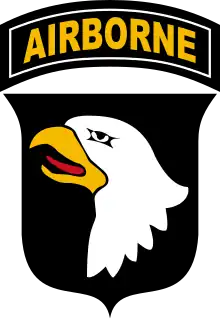 101st Airborne Division, Major General Maxwell D. Taylor
101st Airborne Division, Major General Maxwell D. Taylor
- 501st Parachute Infantry Regiment Colonel Howard R. Johnson
- 502nd Parachute Infantry Regiment Colonel George V. H. Moseley, Jr. (WIA 6 June)
- Lieutenant Colonel John H. Michaelis (6 June)
- 506th Parachute Infantry Regiment Colonel Robert Sink
- 327th Glider Infantry Regiment Colonel George S. Wear
- Colonel Joseph H. Harper (10 June)
 4th Cavalry Group (Mechanized), Colonel Joseph M. Tully
4th Cavalry Group (Mechanized), Colonel Joseph M. Tully
- 4th Cavalry Squadron Lieutenant Colonel E. C. Dunn
- 24th Cavalry Squadron Lieutenant Colonel F. H. Gaston, Jr.
 6th Armored Group, Colonel Francis F. Fainter
6th Armored Group, Colonel Francis F. Fainter
- 70th Tank Battalion Lieutenant Colonel John C. Welborn
- 746th Tank Battalion Lieutenant Colonel C. G. Hupfer
| Unit | Total | Killed | Wounded | Missing | Captured |
|---|---|---|---|---|---|
| All Units | 22,119 | 2,811 | 13,564 | 5,665 | 79 |
| 4th Inf Division | 5,452 | 844 | 3,814 | 788 | 6 |
| 9th Inf Division | 5,438 | 301 | 2,061 | 76 | 0 |
| 79th Inf Division | 2,438 | 240 | 1,896 | 240 | 0 |
| 90th Inf Division | 2,376 | 386 | 1,979 | 34 | 0 |
| 82d A/B Div. | 4,480 | 457 | 1,440 | 2,571 | 12 |
| 101st A/B Div. | 4,670 | 546 | 2,217 | 1,907 | 0 |
| Corps Troops | 304 | 37 | 157 | 49 | 61 |
Cold War
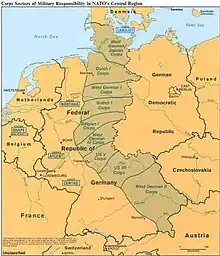

From reactivation in 1950 and throughout the Cold War, the corps guarded part of NATO's front with the Warsaw Pact. Headquartered in Stuttgart at Kelley Barracks it was one of the two main US combat formations in Germany along with V Corps, which was headquartered in Frankfurt am Main at Abrams Building.
As finally envisaged in the General Defense Plan circa 1989, the 1st Canadian Division with its main headquarters at Kingston, Ontario, would have been assigned to the Commander, Central Army Group's tactical reserve, fighting alongside either the German II Corps or VII Corps.[8]
Structure 1989
At the end of the Cold War in 1989 VII Corps consisted of the following units:
 VII Corps, Stuttgart, West Germany[9]
VII Corps, Stuttgart, West Germany[9]
- 1st Armored Division, Ansbach
- 1st Infantry Division (Mechanized), Fort Riley, Kansas (Operation Reforger unit)
- 1st Infantry Division (Forward), Göppingen, West Germany
- 3rd Infantry Division (Mechanized), Würzburg
- VII Corps Artillery, Augsburg
- 2nd Armored Cavalry Regiment, Nuremberg
- 11th Aviation Brigade, Illesheim
- 7th Engineer Brigade, Kornwestheim
- 14th Military Police Brigade, Kornwestheim
- 93rd Signal Brigade (Corps), Ludwigsburg
- 207th Military Intelligence Brigade, Ludwigsburg
- 2nd Corps Support Command, Nellingen auf den Fildern
- 602nd Air Support Operations Group, USAF[10] Stuttgart
Gulf War

After Saddam Hussein's troops invaded Kuwait in 1990, the corps was deployed to Saudi Arabia as part of the second major wave of deployments of American forces. Its presence took US forces in theatre from a force capable of defending Saudi Arabia to a force capable of ejecting Iraqi troops from Kuwait.
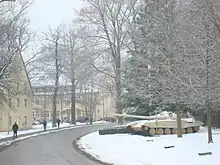

In the Gulf War, VII Corps was probably the most powerful formation of its type ever to take to the battlefield. Normally, a corps commands three divisions when at full strength, along with other units such as artillery of various types, corps-level engineers and support units. However, VII Corps had far more firepower under its command. It consisted of 1,487 tanks, 1,384 infantry fighting vehicles, 568 artillery pieces, 132 MLRS, 8 missile launchers, and 242 attack helicopters.[11] It had a total troop strength of 146,321 troops.[12]
Its principal full strength fighting formations were the 1st Armored Division (United States), the 3rd Armored Division (United States) and the 1st Infantry Division (United States). The 2nd Armored Division (Forward) was assigned to the 1st Infantry Division as its third maneuver brigade.[13] In addition, the corps had the 2nd Cavalry Regiment (United States) to act as a scouting and screening force, and two further heavy divisions, the 1st Cavalry Division (United States) and the British 1st Armorued Division, as well as the 11th Aviation Group.[14][15][16] Although both 1st Cavalry Division and 1st Armoured Division had only two maneuver brigades, they were still immensely powerful formations in their own right.
VII Corps was originally deployed to provide an offensive option if needed. In the 100-hour war they were given a mission: To destroy the Iraqi Republican Guard's heavy divisions. That meant that the 1st Infantry Division had to make a forced entry to make room for the British attack on the right wing and to secure the main forces advance on the left. That attack force was led by the 2nd Armored Cavalry Regiment and Task Force 1-41 Infantry followed by the other two brigades of the 1st Infantry Division.[14] The 1st Armored Division would head north to engage the Iraqi Republican Guard in the Battle of Medina Ridge.[17] The 3rd Armored Division would protect the flank of the 1st Infantry Division. That gave VII Corps commander General Frederick M. Franks, Jr. a three division strike force to confront several Iraqi Armored Divisions. After the corps had turned 90 degrees east according to FRAGPLAN 7 and after the Cavalry Regiment had fought the single sided Battle of 73 Easting the three Divisions (plus the British on the right wing) fought one of the most one-sided battles in the history of the U.S. Army.
VII Corps cut a swath through Iraqi forces. It advanced with U.S. XVIII Airborne Corps on its left wing and Arab forces on its right wing. Led by Task Force 1-41 Infantry it pulverized all Iraqi forces that tried to stand and fight and destroyed a good proportion of the Iraqi Republican Guard divisions.[14] This confrontation was known as the Battle of Norfolk.[18]
VII Corps' attack destroyed several divisions including the Medina and the Tawakalna Republican Guards division along with support units. It also destroyed most of the Iraqi VII Corps that had guarded the frontline as well as other units. The Battle of 73 Easting was studied as a textbook armored battle within the US armored units. The cost in lives was 36 US and UK dead; trifling in terms of expected casualties for the war the two armies had trained for against the Soviets.
Virtually every manoeuvre battalion in the 1st and 3rd Armored Divisions, 1st Inf Div (M), and 2 ACR received the Valorous Unit Award. In addition, six of the ten VII Corps manoeuvre brigade headquarters that saw substantial combat against the Republican Guard received the VUA in contravention of the spirit, if not the letter, of AR672-5-1's guidance that "[o]nly on rare occasions will a unit larger than a battalion qualify for award of the VUA."[19]
During the Gulf War VII Corps destroyed nearly 1,350 Iraqi tanks, 1,224 armored troop carriers, 285 artillery pieces, 105 air defense systems, 1,229 trucks, and lost nearly 36 armored vehicles. They suffered a total of 47 dead and 192 wounded.[20]
VII Corps[21]
 1st Armored Division
1st Armored Division- MG Ronald H. Griffith
.svg.png.webp) 3rd Brigade, 3rd Infantry Division (Mech) – Acting 1st Brigade
3rd Brigade, 3rd Infantry Division (Mech) – Acting 1st Brigade
- 4th BN, 66th Armor Regiment
- 1st BN, 7th Infantry Regiment (Mech)
- 4th BN, 7th Infantry Regiment (Mech)
- 2nd BN, 41st Field Artillery Regiment (155SP)
- 2nd Brigade
- 1st BN, 35th Armor Regiment
- 2nd BN, 70th Armor Regiment
- 4th BN, 70th Armor Regiment
- 6th BN, 6th Infantry Regiment (Mech)
- 2nd BN, 1st Field Artillery Regiment (155SP)
- 3rd Brigade
- 3rd BN, 35th Armor Regiment
- 1st BN, 37th Armor Regiment
- 7th BN, 6th Infantry Regiment (Mech)
- 3rd BN, 1st Field Artillery Regiment (155SP)
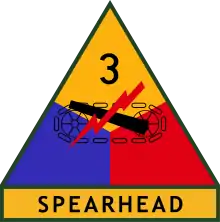 3rd Armored Division
3rd Armored Division- MG Paul E. Funk
- 1st Brigade
- 4th BN, 32nd Armor Regiment
- 4th BN, 34th Armor Regiment
- 3rd BN, 5th Cavalry Regiment (Mech)
- 5th BN, 5th Cavalry Regiment (Mech)
- 3rd BN, 1st Field Artillery Regiment (155SP)
- 2nd Brigade
- 4th BN, 18th Infantry Regiment (Mech)
- 3rd BN, 8th Cavalry Regiment (Armor)
- 4th BN, 8th Cavalry Regiment (Armor)
- 4th BN, 82nd Field Artillery Regiment (155SP)
- 3rd Brigade
- 5th BN, 18th Infantry Regiment (Mech)
- 2nd BN, 67th Armor Regiment
- 4th BN, 67th Armor Regiment
- 2nd BN, 82nd Field Artillery Regiment (155SP)
- 1st Brigade
.svg.png.webp) 1st Infantry Division (Mech)
1st Infantry Division (Mech)- MG Thomas Rhame
- 1st Brigade
- 5th BN, 16th Infantry Regiment (Mech)
- 1st BN, 34th Armor Regiment
- 2nd BN, 34th Armor Regiment
- 1st Bn, 5th Field Artillery Regiment (155SP)
- 2nd Brigade
- 2nd BN, 16th Infantry Regiment (Mech)
- 3rd BN, 37th Armor Regiment
- 4th BN, 37th Armor Regiment
- 4th Bn, 5th Field Artillery Regiment (155SP)
 3rd Brigade, 2nd Armored Division – Acting 3rd Brigade
3rd Brigade, 2nd Armored Division – Acting 3rd Brigade
- 1st BN, 41st Infantry Regiment (Mech)
- 2nd BN, 66th Armor Regiment
- 3rd BN, 66th Armor Regiment
- 4th Bn, 3rd Field Artillery Regiment (155SP)
- 1st Brigade
- 1st (UK) Armoured Division[22]
- Maj Gen Rupert Smith
 4th Armoured Brigade
4th Armoured Brigade- Brig. Christopher Hammerbeck
- 14th/20th King's Hussars & squadron of Life Guards (Challenger 1)
- 1st Bn, Royal Scots (Warrior)
- 3rd Bn, Royal Regiment of Fusiliers (Warrior)
- 2nd Field Regiment RA (155SP)
- 23 Engineer Regiment (AVRE)
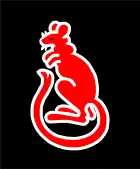 7th Armoured Brigade
7th Armoured Brigade- Brig. Patrick Cordingley
- Royal Scots Dragoon Guards & troops of 17th/21st Lancers (Challenger)
- Queen's Royal Irish Hussars (Challenger)
- 1st Bn, Staffordshire Regiment (Warrior)
- 40th Field Regiment RA (155SP)
- 21 Engineer Regiment (AVRE)
- Divisional Armoured Reconnaissance unit
- Divisional Artillery Group
.svg.png.webp) 1st Cavalry Division(-) Missing 3rd Brigade
1st Cavalry Division(-) Missing 3rd Brigade- MG John H. Tilelli, Jr.
- 1st Brigade
- 3rd BN, 32nd Armor Regiment
- 2nd BN, 8th Cavalry Regiment (Armor)
- 2nd BN, 5th Cavalry Regiment (Mech)
- 1st BN, 82nd Field Artillery Regiment (155SP)
- 2nd Brigade
- 1st BN, 32nd Armor Regiment
- 1st BN, 5th Cavalry Regiment (Mech)
- 1st BN, 8th Cavalry Regiment (Armor)
- 3rd BN, 82nd Field Artillery Regiment (155SP)
- 1st Brigade

Corps assets
 11th Aviation Brigade
11th Aviation Brigade
- 2nd Squadron 6th Cavalry
- 4th Battalion 229th Attack Helicopter Regiment
- 6th Squadron 6th Cavalry
- 7th Engineer Brigade[23]
- 109th Engineer Group SD ARNG – Supported VII Corp
- 9th Engineer Battalion (CBT)(MECH)
- 527th Engineer Battalion (CBT HVY) LA ARNG
- 176th Engineer Group VA ARNG – Supported 1st Inf Div
- 19th Engineer Battalion (Corps CBT)
- 54th Engineer Battalion (CBT)(MECH)
- 82nd Engineer Battalion (CBT)(MECH)
- 92nd Engineer Battalion (CBT HVY)
- 565th Engineer Battalion
- 649th Engineer Battalion (TOPO)
- 926th Engineer Group USAR – Supported 1st Arm Div
- 249th Engineer Battalion (CBT HVY)
- 317th Engineer Battalion (CBT)(MECH)
- 588th Engineer Battalion (CORPS CBT)
- 109th Engineer Group SD ARNG – Supported VII Corp
 42nd Field Artillery Brigade – Supported 1st Inf Div, 3rd Armd Div
42nd Field Artillery Brigade – Supported 1st Inf Div, 3rd Armd Div
- 3rd BN, 20th Field Artillery Regiment (155SP)
- 1st BN, 27th Field Artillery Regiment (MLRS)
- 2nd BN, 29th Field Artillery Regiment (155SP)
 75th Field Artillery Brigade – Supported 1st Inf Div, 1st Armd Div
75th Field Artillery Brigade – Supported 1st Inf Div, 1st Armd Div
- 1st BN, 17th Field Artillery Regiment (155SP)
- 5th BN, 18th Field Artillery Regiment (203SP)
- 1st BN, 158th Field Artillery Regiment (MLRS) OK ARNG
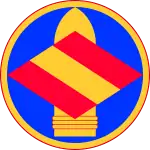 142nd Field Artillery Brigade AR ARNG – Supported 1st Inf Div, 1st UK Armd Div
142nd Field Artillery Brigade AR ARNG – Supported 1st Inf Div, 1st UK Armd Div
- 1st BN, 142nd Field Artillery Regiment (203SP) AR ARNG
- 2nd BN, 142nd Field Artillery Regiment (203SP) AR ARNG
 210th Field Artillery Brigade – Supported 2nd ACR, 1st Inf Div
210th Field Artillery Brigade – Supported 2nd ACR, 1st Inf Div
- 3rd BN, 17th Field Artillery Regiment (155SP)
- 6th BN, 41st Field Artillery Regiment (155SP)
- C Btry, 4th Battalion, 27th Field Artillery (MLRS)
- 2nd Corps Support Command[24]
- 7th Corps Support Group
- 6th Transportation Battalion
- 71st Maintenance Battalion
- 87th Maintenance Battalion
- 213th Support Battalion
- 16th Corps Support Group
- 4th Transportation Battalion
- 101st Ordinance Battalion
- 13th Support Battalion
- 300th Service & Support Battalion
- 30th Corps Support Group NC ARNG
- 136th Quartermaster Battalion
- 690th Maintenance Battalion
- 43rd Corps Support Group
- 68th Transportation Battalion
- 169th Maintenance Battalion
- 544th Maintenance Battalion
- 553rd Service & Support Battalion
- 159th Corps Support Group USAR
- 286th Supply & Service Battalion ME ARNG
- 7th Corps Support Group
 332nd Medical Brigade USAR[25]
332nd Medical Brigade USAR[25]
- 127th Medical Group AL ARNG
- 31st Combat Support Hospital
- 128th Combat Support Hospital
- 377th Combat Support Hospital USAR
- 403rd Combat Support Hospital USAR
- 341st Medical Group USAR
- 159th Mobile Army Surgical Hospital LA ARNG
- 475th Mobile Army Surgical Hospital KY ARNG
- 807th Mobile Army Surgical Hospital USAR
- 912th Mobile Army Surgical Hospital USAR
- 345th Combat Support Hospital USAR – Converted to a MASH in January
- Task Forces Evac (Provisional)
- 12th Evacuation Hospital
- 13th Evacuation Hospital WI ARNG
- 148th Evacuation Hospital AR ARNG
- 312th Evacuation Hospital USAR
- 410th Evacuation Hospital USAR
- 127th Medical Group AL ARNG
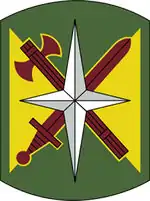 14th Military Police Brigade[26]
14th Military Police Brigade[26]
- 93rd Military Police Battalion
- 95th Military Police Battalion
- 118th Military Police Battalion RI ARNG
- 372nd Military Police Battalion DC ARNG
- 793rd Military Police Battalion
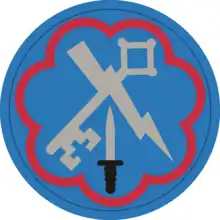 207th Military Intelligence Brigade
207th Military Intelligence Brigade
- 2nd Military Intelligence Battalion
- 307th Military Intelligence Battalion
- 511th Military Intelligence Battalion
Redeployment and inactivation
After the fighting was over, most VII Corps units were redeployed directly to the United States for reassignment or inactivation. VII Corps HQ returned to Germany and was disbanded as part of the post-Cold War American defense spending cuts. Some VII Corps units remained in Germany and were reassigned to V Corps or USAREUR. A farewell ceremony was held in downtown Stuttgart at Schlossplatz, where the VII Corps colors were retired on 18 March 1992.[27] The official inactivation was held at Fort McPherson, Ga., in April 1992.[28]
Commanders during the Cold War and Gulf War
- Maj. Gen. Withers A. Burress - June 1951 - December 1952
- Maj. Gen. James M. Gavin - December 1952 - March 1954
- Lt. Gen. Henry I. Hodes - March 1954 - February 1955
- Lt. Gen. George H. Decker - February 1955 - May 1956
- Maj. Gen. Halley G. Maddox - June - July 1956
- Lt. Gen. John F. Uncles - August 1956 - August 1958
- Lt. Gen. Gordon B. Rogers - September 1958 - October 1959
- Lt. Gen. Guy S. Meloy Jr. - October 1959 - January 1961
- Lt. Gen. John C. Oakes - January 1961 - April 1962
- Lt. Gen. C. H. Bonesteel III - April 1962 - August 1963
- Lt. Gen. Louis W. Truman - September 1963 - July 1965
- Lt. Gen. Frank T. Mildren - July 1965 - May 1968
- Lt. Gen. Donald V. Bennett - June 1968 - September 1969
- Lt. Gen. George G. O'Connor - October 1969 - February 1971
- Lt. Gen. Fillmore K. Mearns - February 1971- March 1973
- Lt. Gen. George S. Blanchard - March 1973 - June 1975
- Lt. Gen. Frederick J. Kroesen - July 1975 - October 1976
- Lt. Gen. David E. Ott - October 1976 - October 1978
- Lt. Gen. Julius W. Becton Jr. - October 1978 - June 1981
- Lt. Gen. William J. Livsey - June 1981 - July 1983
- Lt. Gen. John R. Galvin - July 1983 - February 1985
- Lt. Gen. Andrew P. Chambers - February 1985 - July 1987
- Lt. Gen. Ronald L. Watts - July 1987 - August 1989
- Lt. Gen. Frederick M. Franks Jr. - August 1989 - June 1991
- Lt. Gen. Michael Spiglemire - August 1991 - 1992 (Inactivation)[29]
References
- Wilson, John B. (1999). Armies, Corps, Divisions, and Separate Brigades. Washington, DC: U.S. Army Center of Military History. p. 66. ISBN 978-0-16-049992-0.
- "American Expeditionary Forces Commanders, 1917-1919". Fleet Organization.com. Stephen Svonavec. 2001. Retrieved 8 November 2020.
- Clay 2010, p. 160.
- "Mission Accomplished Story of the VII Corps". Xixcorps.nl. Retrieved 24 June 2013.
- "VII Corps in WWII". Vii-corps.org. Archived from the original on 16 April 2013. Retrieved 24 June 2013.
- "The Mons Pocket, or the "Petit Stalingrad" of the Borinage". Europe Remembers. Liberation Route Europe Foundation. Retrieved 21 March 2021.
- VII Corps, G-1 Reports, June 1944
- See Sean M. Maloney, War Without Battles: Canada's NATO Brigade in Germany 1951–1993, McGraw-Hill Ryerson Ltd, (Toronto, Montreal, and others) 1997.
- Army - The Magazine of Landpower - October 1989 (1989). "Command and Staff". Association of the US Army. Retrieved 26 June 2020.
- "602nd Air Support Operations Group". airforce.togetherweserved.com. Air Force: We served Together. Retrieved 15 January 2017.
- Bourque p.90
- Bourque p.473
- Dinackus 2000, p. 4–10.
- VUACit 2014.
- Bourque & Burdan 2007, p. 275.
- Bourque & Burdan 2007, p. 377.
- Bourque & Burdan 2007, p. 355.
- Bourque, p.144
- Thomas D. Dinackus, 2000, 14-4 and 14-5.
- "Victory Misunderstood: What the Gulf War Tells Us About the Future of Conflict - The RMA Debate". www.comw.org.
- "Order of Battle for VII Corps". www.tim-thompson.com.
- British Ground Force in the Gulf War, 1990–91 Archived 2011-08-11 at the Wayback Machine orbat.com
- "7Th Engineer Brigade". Archived from the original on 19 December 2014. Retrieved 11 May 2011.
- "2Nd Corps Support Command". Archived from the original on 19 December 2014. Retrieved 14 May 2011.
- "14Th Military Police Brigade". Archived from the original on 19 December 2014. Retrieved 12 May 2011.
- "14Th Military Police Brigade". Archived from the original on 19 December 2014. Retrieved 11 May 2011.
- "USAREUR Docs - The Citizen".
- "Stuttgart employee reflects on 46 years of service". Archived from the original on 24 March 2014. Retrieved 8 January 2014.
- "USAREUR Units & Kasernes, 1945 - 1989". Usarmygermany.com. Retrieved 24 June 2013.
- Bourque, Stephen A. (2002). Jayhawk! The VII Corps in the Persian Gulf War. Washington, DC: Center of Military History Publication. 70-73-1.
- Bourque, Stephen A.; Burdan, John (2007). The road to Safwan the 1st Squadron, 4th Cavalry in the 1991 Persian Gulf War. Denton, TX: University of North Texas Press. ISBN 9781574412321.
- Casey, Melanie (13 July 2004), "From Helenen Kaserne to Kelley Barracks", Stuttgart Citizen (Stuttgart, Germany): P 10
- "Desert Storm/Shield Valorous Unit Award (VUA) Citations". US Army Center of Military History. Retrieved 26 December 2014.
- Clancy, Tom (2007). Into The Storm: A Study in Command. Berkley Trade.
- Clay, Steven E. (2010). US Army Order of Battle 1919–1941, Vol. 1: The Arms: Major Commands and Infantry Organizations (PDF). Fort Leavenworth, Kansas: Combat Studies Institute Press.
 This article incorporates text from this source, which is in the public domain.
This article incorporates text from this source, which is in the public domain. - Dinackus, Thomas D. (2000). Order of Battle: Allied Ground Forces of Operation Desert Storm. Central Point, Oregon: Hellgate Press. ISBN 1-55571-493-5.
- Draft Report The Battle of 73 Easting, 26 February 1991, a historical introduction to a simulation. Krause, Col Michael, US Army Center of Military History, 2 May 1991.
- Ryan, John (May 1998). Battle Command in the Storm: Lieutenant General Franks and VII Corps. School of Advanced Military Studies United States Army Command and General Staff College.
- Gavin, James M. (1978). On To Berlin. New York, NY: Viking Press/Penguin Books Canada Limited. ISBN 0-670-52517-0.